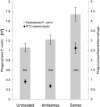Effect of transcription factor GATA-2 on phagocytic activity of alveolar macrophages from Pneumocystis carinii-infected hosts
- PMID: 12933836
- PMCID: PMC187340
- DOI: 10.1128/IAI.71.9.4943-4952.2003
Effect of transcription factor GATA-2 on phagocytic activity of alveolar macrophages from Pneumocystis carinii-infected hosts
Abstract
Alveolar macrophages from Pneumocystis carinii-infected hosts are defective in phagocytosis (W. Chen, J. W. Mills, and A. G. Harmsen, Int. J. Exp. Pathol. 73:709-720, 1992; H. Koziel et al., J. Clin. Investig. 102:1332-1344, 1998). Experiments were performed to determine whether this defect is specific for P. carinii organisms. The results showed that these macrophages were unable to phagocytose both P. carinii organisms and fluorescein isothiocyanate (FITC)-conjugated latex beads, indicating that alveolar macrophages from P. carinii-infected hosts have a general defect in phagocytosis. To determine whether this defect correlates with the recently discovered down-regulation of the GATA-2 transcription factor gene during P. carinii infection, alveolar macrophages from dexamethasone-suppressed or healthy rats were treated with anti-GATA-2 oligonucleotides and then assayed for phagocytosis. Aliquots of the alveolar macrophages were also treated with the sense oligonucleotides as the control. Cells treated with the antisense oligonucleotides were found to have a 46% reduction in phagocytosis of P. carinii organisms and a 65% reduction in phagocytosis of FITC-latex beads compared to those treated with the sense oligonucleotides. To determine whether the defect in phagocytosis in alveolar macrophages from P. carinii-infected hosts can be corrected by overexpression of GATA-2, a plasmid containing the rat GATA-2 gene in the sense orientation driven by the cytomegalovirus (CMV) promoter was introduced into alveolar macrophages from P. carinii-infected rats. Aliquots of the same cells transfected with a plasmid containing GATA-2 in the antisense orientation relative to the CMV promoter served as the control. Alveolar macrophages treated with the sense GATA-2 expression construct were found to increase their phagocytic activity by 66% in phagocytosis of P. carinii organisms and by 280% in phagocytosis of FITC-latex beads compared to those that received the antisense GATA-2 construct. The results of this study indicate that GATA-2 plays an important role in the regulation of phagocytosis in alveolar macrophages during P. carinii infection.
Figures







Similar articles
-
Effect of the transcription factor GATA-2 on phagocytic activity of alveolar macrophages from Pneumocystis carinii-infected hosts.J Eukaryot Microbiol. 2001;Suppl:158S-159S. doi: 10.1111/j.1550-7408.2001.tb00499.x. J Eukaryot Microbiol. 2001. PMID: 11906041 No abstract available.
-
Effect of bronchoalveolar lavage fluid from Pneumocystis carinii-infected hosts on phagocytic activity of alveolar macrophages.Infect Immun. 2004 Apr;72(4):2140-7. doi: 10.1128/IAI.72.4.2140-2147.2004. Infect Immun. 2004. PMID: 15039336 Free PMC article.
-
Microarray studies on effects of Pneumocystis carinii infection on global gene expression in alveolar macrophages.BMC Microbiol. 2010 Apr 8;10:103. doi: 10.1186/1471-2180-10-103. BMC Microbiol. 2010. PMID: 20377877 Free PMC article.
-
Alveolar macrophage and glycoprotein responses to Pneumocystis carinii.Semin Respir Infect. 1998 Dec;13(4):339-47. Semin Respir Infect. 1998. PMID: 9872631 Review.
-
Mechanisms of defence in the lung: lessons from Pneumocystis carinii pneumonia.Sarcoidosis Vasc Diffuse Lung Dis. 2000 Jun;17(2):130-9. Sarcoidosis Vasc Diffuse Lung Dis. 2000. PMID: 10957761 Review.
Cited by
-
GATA2 deficiency: a protean disorder of hematopoiesis, lymphatics, and immunity.Blood. 2014 Feb 6;123(6):809-21. doi: 10.1182/blood-2013-07-515528. Epub 2013 Nov 13. Blood. 2014. PMID: 24227816 Free PMC article.
-
GATA2 Deficiency With Early-Onset and Progressive Interstitial Lung Disease.Respirol Case Rep. 2025 Apr 22;13(4):e70165. doi: 10.1002/rcr2.70165. eCollection 2025 Apr. Respirol Case Rep. 2025. PMID: 40264496 Free PMC article.
-
Diffuse parenchymal lung disease as first clinical manifestation of GATA-2 deficiency in childhood.BMC Pulm Med. 2015 Feb 10;15:8. doi: 10.1186/s12890-015-0006-2. BMC Pulm Med. 2015. PMID: 25879889 Free PMC article.
-
Cancers Related to Immunodeficiencies: Update and Perspectives.Front Immunol. 2016 Sep 20;7:365. doi: 10.3389/fimmu.2016.00365. eCollection 2016. Front Immunol. 2016. PMID: 27703456 Free PMC article. Review.
-
Master regulatory GATA transcription factors: mechanistic principles and emerging links to hematologic malignancies.Nucleic Acids Res. 2012 Jul;40(13):5819-31. doi: 10.1093/nar/gks281. Epub 2012 Apr 5. Nucleic Acids Res. 2012. PMID: 22492510 Free PMC article. Review.
References
-
- Bell, E., A. Lumsden, and A. Graham. 1999. Expression of GATA-2 in the developing avian rhombencephalon. Mech. Dev. 84:173-176. - PubMed
-
- Bouhassira, E. E., M. F. Kielman, J. Gilman, M. F. Fabry, S. Suzuka, O. Leone, E. Gikas, L. F. Bernini, and R. L. Nagel. 1997. Properties of the mouse alpha-globin HS-26: relationship to HS-40, the major enhancer of human alpha-globin gene expression. Am. J. Hematol. 54:30-39. - PubMed
-
- Castro, M., T. I. Morgenthaler, O. A. Hoffman, J. E. Standing, M. S. Rohrbach, and A. H. Limper. 1993. Pneumocystis carinii induces the release of arachidonic acid and its metabolites from alveolar macrophages. Am. J. Respir. Cell Mol. Biol. 9:73-81. - PubMed
-
- Centers for Disease Control and Prevention. 1997. AIDS-indicator conditions diagnosed in patients reported in 1996, by age group, United States. HIV/AIDS Surveillance Rep. 8:18.
Publication types
MeSH terms
Substances
Associated data
- Actions
Grants and funding
LinkOut - more resources
Full Text Sources
Molecular Biology Databases

